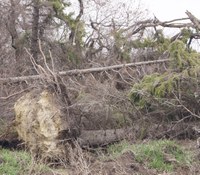Stay safe when cleaning up storm-damaged trees
(Click the image below to view a high-resolution image that can be downloaded)
While tree-care companies and others are working to clean up trees and branches after this weekend’s storms, many homeowners are doing the same thing. Joe Zeleznik, North Dakota State University Extension forester, encourages homeowners to stay safe while cleaning up storm-damaged trees.
When working with trees and branches, rule number one is to avoid downed power lines, says Zeleznik. Live power lines can kill or injure a person through direct contact or indirectly, when downed trees and branches conduct electricity into a person working on them. Avoid these situations until the power company declares that it is safe to do so. Let these professionals do their job first, before you do yours.
Second, be aware of the ways that stems and branches can move once they are no longer attached to each other. Branches or small stems that are being held down by heavier stems can act like springs, releasing a lot of energy once they are free. Other branches may move up, down or sideways, depending on where they are in a pile. Those moving pieces can easily knock a person off-balance or even cause severe injury.
Wear the appropriate Personal Protective Equipment (PPE) when operating a chainsaw or other power tools, says Zeleznik. Wearing a hard hat, gloves, hearing protection and boots will go a long way towards protecting you from scrapes and cuts. Chainsaw safety chaps provide outstanding protection against the serious harm that can come from this dangerous piece of equipment.
“Know what’s beyond your capacity and hire a professional when necessary,” says Zeleznik. “There are many highly trained and experienced individuals throughout the state who have the equipment and know-how to remove damaged trees and debris safely. Split stems, rotted stems and large unattached branches that are high off the ground can be very dangerous to remove and should be taken care of by the professionals.”
Finally, when hiring a tree-care company, make sure to ask for proof of insurance before entering into a service contract, advises Zeleznik.
For more details about dealing with disasters and stress, visit NDSU’s disaster education website at ndsu.ag/disasterinfo.
NDSU Agriculture Communication – June 25, 2025
Source: Joe Zeleznik, 701-231-8143, joseph.zeleznik@ndsu.edu
Editor: Kelli Anderson,701-231-6136, kelli.c.anderson@ndsu.edu


